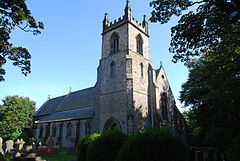Lydiate
| Lydiate | |
|---|---|
| Village | |
 St. Thomas' Church, Lydiate |
|
| Lydiate shown within Merseyside | |
| Population | 6,308 (2011 Census) |
| OS grid reference | SD368040 |
| Civil parish |
|
| Metropolitan borough | |
| Metropolitan county | |
| Region | |
| Country | England |
| Sovereign state | United Kingdom |
| Post town | LIVERPOOL |
| Postcode district | L31 |
| Dialling code | 0151 |
| Police | Merseyside |
| Fire | Merseyside |
| Ambulance | North West |
| EU Parliament | North West England |
| UK Parliament | |
Lydiate is a village and civil parish in the Metropolitan Borough of Sefton on Merseyside, England but historically in Lancashire.
It is located to the north of Maghull, with which it has a common history. At the 2001 Census the village and civil parish of Lydiate had a population of 6,672, reducing to 6,308 at the 2011 Census.
There is evidence that the settlement of the area dates back to at least the middle of the 10th century. Indeed, one possible root of the name is the Old English hlid-geat meaning 'swing gate', which would have an association with animal farming. Lydiate is mentioned in the Domesday Book, and is described as having a "wood a mile long", and there is evidence of the existence of extensive forests at that time, particularly of oak and elm.
The Scotch Piper Inn, located today on the A5147, Southport Road, is reputed to be the oldest inn in Lancashire and dates from the 14th century. For many years the pub was owned and run by the Moorcroft family. Originally called "The Royal Oak", the inn was built around an oak tree which can be seen in both the tap room and the front bar to the left of the fireplace. The inn is now a Grade II* listed building.
The Ireland family were very influential in the area in the early 15th century, and Lydiate Hall was built by Lawrence Ireland sometime around 1470. The eastern part of the Hall was destroyed about 1780, and the Hall was abandoned completely by the late 19th century. Only ruins exist today.
The nearby St Catherine's Chapel, commonly known as Lydiate Abbey, appears to date from the same period, with the initials of Lawrence Ireland and his wife, Catherine Blundell, located on the porch. The abbey appears to have been abandoned when the practice of the Catholic religion was prohibited. Local legend holds that a tunnel exists between the Abbey and the Hall to allow the escape of a priest. Another local legend states that the tunnel was between the Abbey and the Scotch Piper in order to allow monks to escape the public house. However, there is no documented evidence of this. The adjacent graveyard was used by local Catholic families into the later 19th century.
...
Wikipedia

